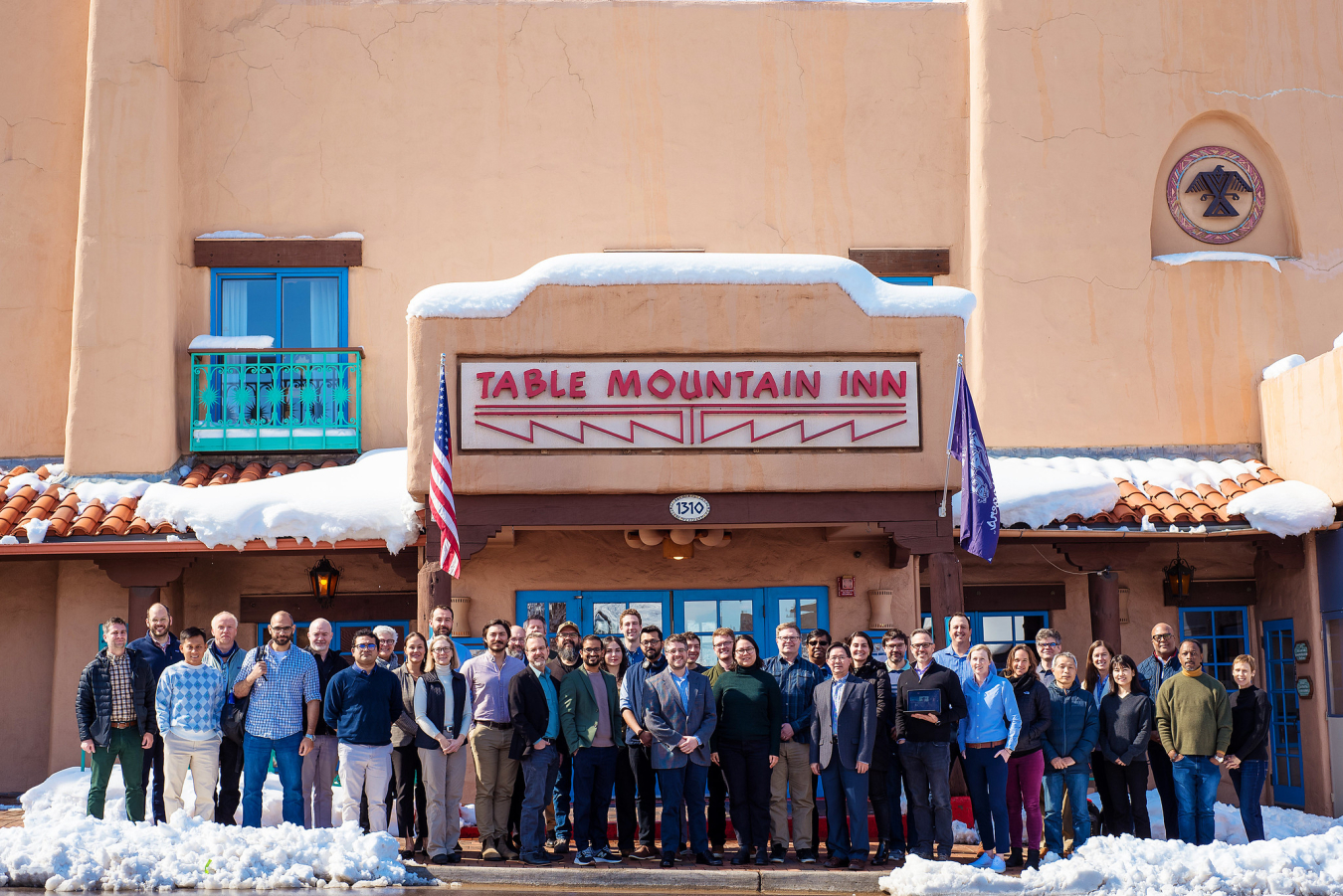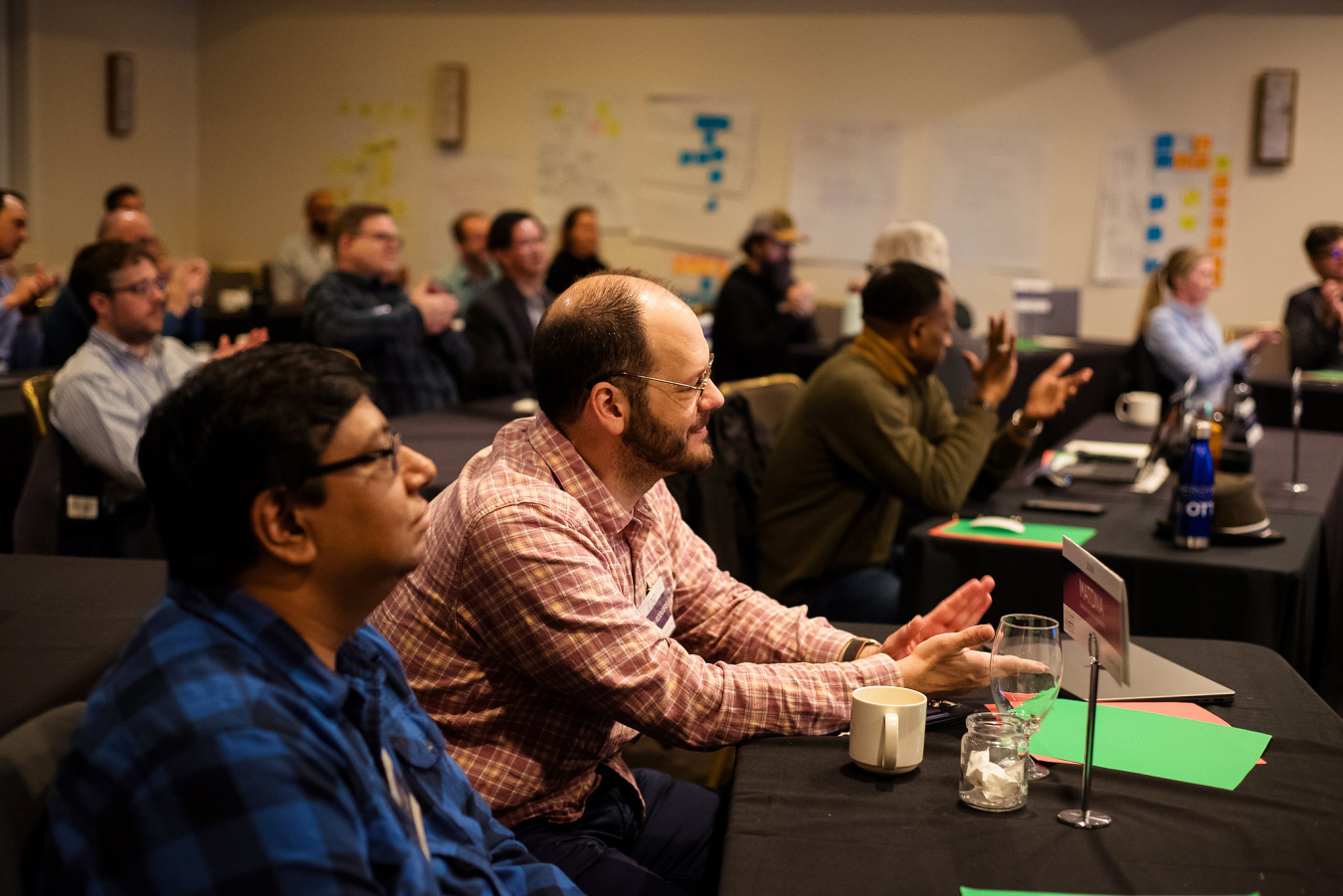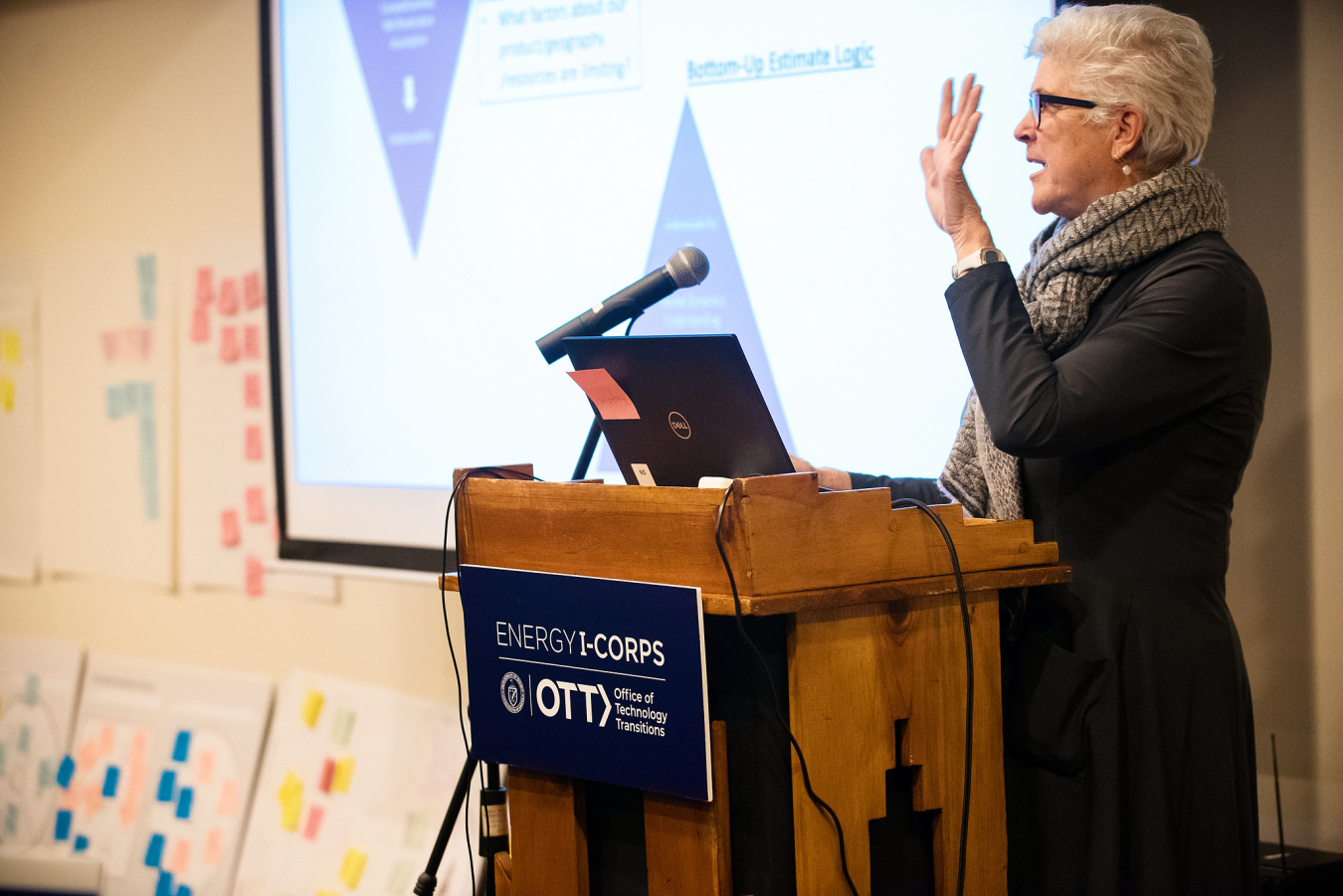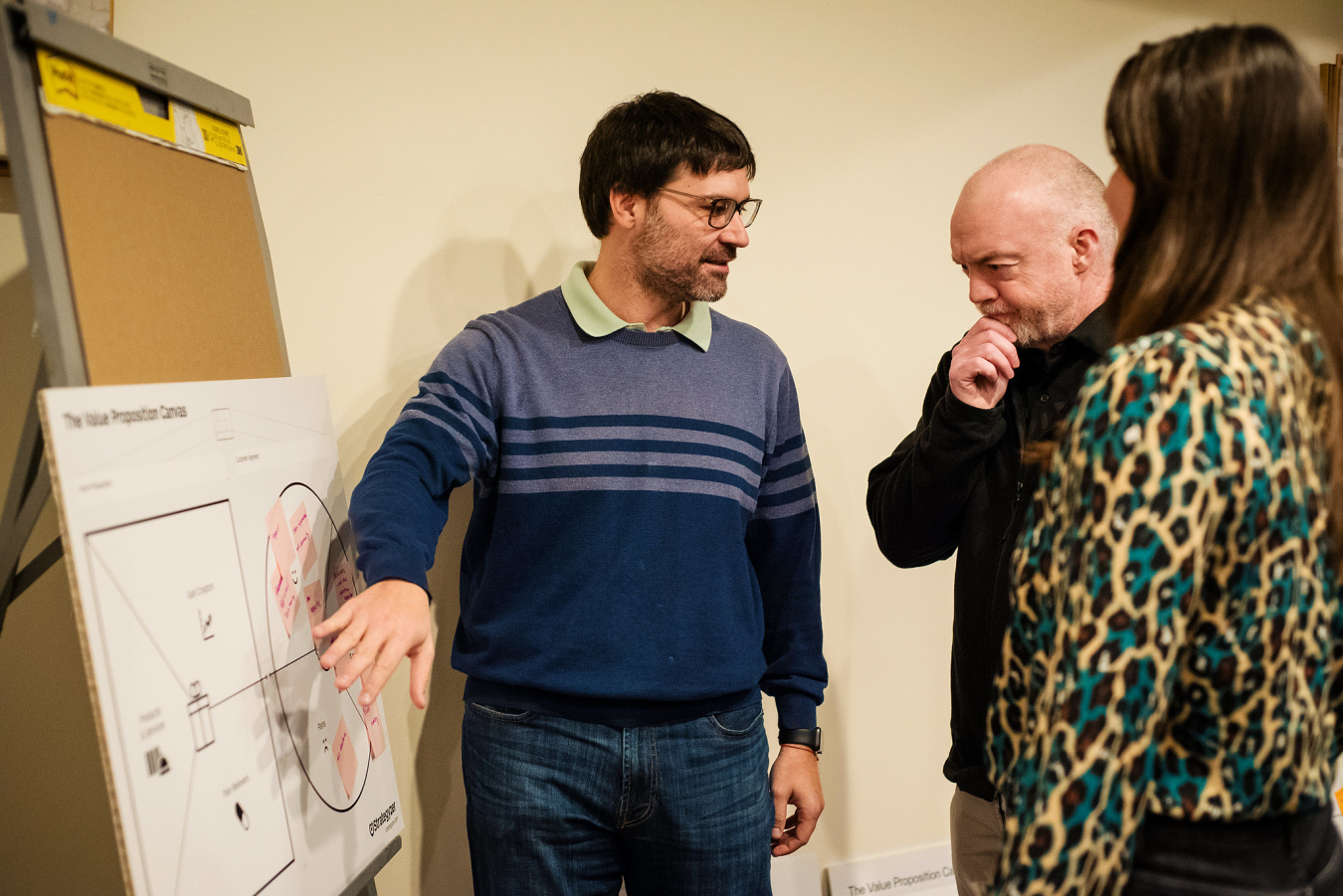Cohort 18 represents 10 National Labs who received funding from 11 DOE program offices and the National Nuclear Security Administration.
Office of Technology Transitions
March 26, 2024Twice a year, National Lab researchers from across the country convene in Golden, Colorado to kick off their Energy I-Corps training. The Energy I-Corps portfolio is a suite of efforts from the U.S. Department of Energy’s (DOE’s) Office of Technology Transitions (OTT) that provides the meaningful application of commercialization and entrepreneurial skills to DOE technologies.
At the core of its three-topic structure is Energy I-Corps’ Topic 2: Training Cohorts, where research teams define value propositions for their technologies, conduct at least 75 stakeholder discovery interviews, and explore viable pathways to bring their DOE technology to the market. Teams are composed of DOE National Lab and DOE plant and site researchers who are pursuing innovations in a wide range of technology areas, paired with an industry mentor who will guide them through the curriculum.

Energy I-Corps Cohort 18 kicked off in Golden, Colo. in mid-March 2024. Photo courtesy of Kira Vos
Kickoff Week
Cohort 18 represents 10 National Labs who received funding from 11 DOE program offices and the National Nuclear Security Administration (NNSA). Three teams participating in DOE’s West Gate Lab-Embedded Entrepreneurship Program (LEEP) will also participate in Cohort 18. Everyone gathered at the National Renewable Energy Laboratory (NREL) for a packed week of trainings, workshops, and networking.

Kickoff week is full of trainings, workshops, and networking to start the two-month immersive program. Photo courtesy of Kira Vos
Participants were joined by the teaching team, who bring critical industry expertise to the program and introduce the language of innovation and commercialization. Instructors leveraged their business and startup experience to provide presentation coaching, stakeholder discovery review, and one-on-one advisory sessions.

Energy I-Corps instructor Jean Redfield, chief financial officer and co-founder of JM Redfield LLC, speaks to the incoming cohort. Photo courtesy of Kira Vos
Guest speakers included Eric Payne and Bill Hadley, licensing executives at NREL's Technology Transfer Office, who spoke about intellectual property and commercializing DOE technologies, respectively. They were joined by Axel Palmstrom and Kelly Schutt, NREL researchers in the Materials Science group, who shared best practices and lessons learned as Energy I-Corps alumni from Cohort 15.

Teams are tasked with conducting at least 75 stakeholder discovery interviews to explore viable pathways to bring their products to market. Photo courtesy of Kira Vos
Since 2015, Energy I-Corps has trained more than 450 National Lab researchers and their technologies have collectively attracted more than $177 million in post-program funding. The past 17 cohorts of graduates have worked with more than 210 industry mentors and conducted 15,500 discovery interviews to determine the commercial impact of their technologies. The success metric is clear: since graduating from Energy I-Corps, teams have launched more than 20 new businesses based on their technologies and executed 78 licenses.
Meet the Teams
Cohort 18’s opening week in Colorado began on March 11, 2024, and will conclude in mid-May. Eleven DOE program offices and the NNSA are funding 14 teams from ten National Labs to participate in this iteration of the program. The Energy I-Corps cohort 18 teams are:
Advanced Cathodes from Argonne National Laboratory: Shielded cathodes are a simple and low-cost process to modify the surface chemistry of lithium-bearing oxides. This novel surface modification technology improves the environmental compatibility of the resulting cathode materials and can enable low-cost, large-scale manufacturing of high-performance cathode materials. Funded by the Advanced Manufacturing and Materials Technologies Office (AMMTO) and the Vehicles Technologies Office (VTO).
ReCapture from NREL: ReCapture is a reactive carbon dioxide (CO2) capture solution. This pioneering technology eliminates emissions by capturing and upgrading waste CO2 in a single unit. The ReCapture process transforms CO2 into value-added chemicals that are currently made from fossil resources. Funded by the Office of Fossil Energy and Carbon Management (FECM) and the Bioenergy Technologies Office (BETO).
Integrated Energy Box from NREL: Box is a technology designed to provide renewable energy support for disaster relief scenarios. The ICEBox (Integrated Combined Energy Box) intelligently adapts to wind, solar, and wave electrical inputs, allowing first responders to assess the energy sources in an area and utilize the greatest potential. Funded by the Water Power Technologies Office (WPTO).
NAIAD from Idaho National Laboratory and Pacific Northwest National Laboratory: There are around 600 dams in the U.S. that could be converted to produce over eight gigawatts of clean energy and the NAIAD team made a national prioritization tool based on benefits to the grid, community, industry, and environment. Funded by WPTO.
InterFluid Sensors from Sandia National Laboratories (SNL): The team has developed a wearable patch that can be self-applied in a pain-free manner to measure circulating biomarkers continuously in real time. Microneedle electrochemical sensors could serve as a tool for analysis of complex medical conditions and illnesses allowing for in situ and simultaneous detection of numerous analytes. Funded by NNSA.
Intercept Imaging from Los Alamos National Laboratory: This technology provides women with non-invasive, cost-effective breast cancer imaging. Combining ultrasound technology and machine learning, Intercept Imaging detects potential early-stage tumors. These advantages benefit women with dense breast tissue, genetic disposition, and other high-risk factors. Funded by the Office of Science Advanced Scientific Computing Research (SC-ASCR) Program.
GreenSight from Oak Ridge National Laboratory (ORNL): Artificial intelligence-based solutions offer considerable benefits but underscore the critical issues of excessive energy use and data security vulnerabilities. The GreenSight team addresses these challenges with a tailored strategy, emphasizing seamless integration of software services while championing sustainability and ensuring data privacy throughout each phase of processing. Funded by SC-ASCR.
MatDNA from SNL: Advanced manufacturing methods often create materials with microscopic structural patterns that are not well described by traditional metrics. The MatDNA technology uses microscopic data analysis techniques to provide a holistic, quantitative measure of material structure that could be used in fields such as advanced manufacturing, material design, geology, and energy materials. Funded by the Geothermal Technologies Office (GTO), AMMTO, and the Office of Science Basic Energy Sciences (SC-BES) Program.
HEMatGan from SNL: This team has developed a unique generative machine learning platform, HEMatGan, for rapidly predicting high entropy materials (HEMs) with pre-determined properties. HEMatGan operates by asking the algorithm for a material with a particular property, thereby inverting the materials design process and instead of designing a material followed by property prediction, you set the property requirements and are directly given a material that meets your needs. Funded by GTO, AMMTO, and the SC-BES.
ENERWAVE from National Energy Technology Laboratory: Utilizing innovative microwave heating, this modular gasification technology efficiently turns diverse feedstocks, including waste plastics, biomass, and tar, into hydrogen-rich syngas. It notably increases hydrogen output by four times and reduces tar production by 30% compared to standard gasification methods. Funded by the Industrial Efficiency and Decarbonization Office (IEDO).
INDRAGUARD from ORNL: This team aims to enhance the lifespan of wind turbine blades (land-based and offshore) and reduce their service downtime by 50% due to lightning strike damages and weathering conditions. They developed a nano-engineered multi-functional coating for blades to provide lightning strike and rain erosion protection. Funded by the Wind Energy Technologies Office (WETO).
PoSeiDOn from NREL: The PoSeiDOn (Powering the Smart Data Ocean) team is developing a self-charging wave-powered ocean glider underwater vehicle that delivers the relevant data and introduces a paradigm shift in the world of ocean observation and knowledge of our oceans. Funded by WPTO.
QICK from Fermi National Accelerator Laboratory: Quantum computing is moving at a very fast pace with governments, industry, and research institutions investing time and effort to move science and technology forward. The QICK is a cheap instrument that provides researchers and scientists with the tools needed to make experimentation seamless without spending much money. Funded by SC-ASCR.
CECIE from Savannah River National Laboratory: The CECIE (combined equilibrium catalytic isotope exchange) process efficiently synthesizes deuterated organic compounds. The CECIE process eliminates deuterium loss and reduces costs by directly converting conventional compounds to their deuterated forms. Funded by OTT.
Colorado Earth from West Gate Lab-Embedded Entrepreneurship Program (LEEP): Colorado Earth’s nature-based solution for the building envelope integrates an ancient building material with recently used phase-change materials. The work is based on the need to develop an energy-efficient building approach that requires no highly insulated assemblies. Funded by AMMTO.
Olokun Minerals from West Gate LEEP: Olokun Minerals’ process aims to provide global clean water security and a reliable supply of critical minerals like lithium and magnesium to help the United States become more energy independent in its transition to renewable energy sources. Funded by AMMTO and IEDO.
Sustainable Chemicals from West Gate LEEP: While plastics offer industry an affordable, reliable product, they pose an environmental threat. To mitigate the environmental repercussions of the plastic industry, Sustainable Chemicals' bioplastic provides a viable alternative that offers high-quality, environmentally friendly materials. Funded by AMMTO.

